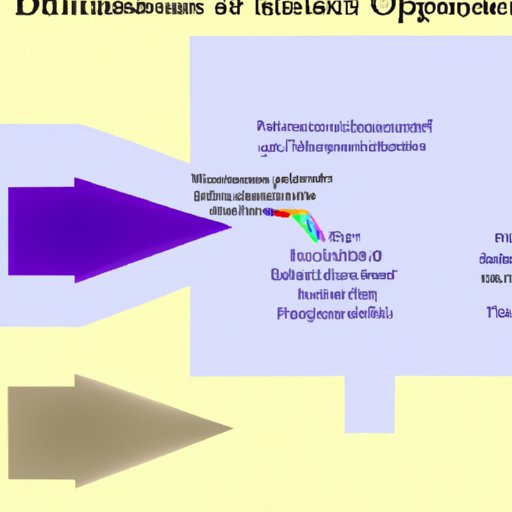Introduction
Diffusion of technology is the process by which new technologies are adopted, adapted, and integrated into society. It is a complex phenomenon that involves the spread of information and ideas from one person or group to another. Diffusion of technology can be seen in many aspects of daily life, from the use of smartphones to the development of new medical treatments.

Exploring Diffusion of Technology: How Technology Moves Through Society
The diffusion of technology involves several stages. Each stage requires the involvement of different stakeholders, such as innovators, adopters, and users. The first stage is the invention, or creation, of a new technology. This can involve research and development, testing, and prototyping. Once a technology has been developed, it must go through a commercialization process before it can be adopted by the general public.
The second stage is called the adoption process. This is when potential users decide whether or not to accept the new technology. They will consider factors such as cost, convenience, and usability. Once a technology has been adopted, it moves into the third stage, which is diffusion. This is when the technology spreads throughout society, becoming more widely accepted and used.
Several factors can influence the diffusion of technology. These include the cost of the technology, the availability of resources, the level of consumer demand, and the presence of supportive policies. Innovations can also play an important role in diffusion, as they can help to make a technology more attractive and easier to use.
Examining the adoption process is key to understanding the diffusion of technology. People tend to adopt new technologies at different rates. Early adopters are usually those who have the most need for the technology, while late adopters may be more conservative or skeptical. It is important to note that not everyone will adopt a technology; some people may choose to remain uninvolved.

Examining the Benefits and Challenges of Diffusion of Technology
Diffusion of technology can bring many benefits to society. One of the main advantages is increased efficiency. For example, new technologies can help to reduce costs by streamlining processes and increasing productivity. They can also provide access to new markets and opportunities.
However, there are some challenges associated with the diffusion of technology. One of the biggest issues is the digital divide, which refers to the gap between those who have access to technology and those who do not. There is also the risk of security breaches and data loss, as well as the potential for misuse of technology.
The Role of Innovation in the Diffusion of Technology
Innovation plays an important role in the diffusion of technology. Innovation can come in many forms, including technological, organizational, and business model innovations. Technological innovations involve the development of new products, services, and processes, while organizational innovations involve changes to existing structures and systems.
Innovations can help to increase the rate of diffusion of technology. By making a technology more user-friendly and accessible, it can become more attractive to potential adopters. Innovations can also make a technology more efficient and cost-effective, which can lead to greater uptake.
Understanding the Impact of Diffusion of Technology on Businesses
Diffusion of technology can have a significant impact on businesses. For example, it can enhance efficiency by streamlining processes and reducing costs. It can also increase reach by allowing businesses to expand their customer base. Additionally, it can improve customer satisfaction by providing better service and more personalized experiences.
Technology can also enable businesses to develop new products and services. This can create competitive advantages and open up new revenue streams. Moreover, it can help businesses to stay ahead of the competition by keeping up with the latest trends and advancements.
Analyzing Diffusion of Technology in Education
Technology has had a major impact on education, particularly in the form of online learning and virtual classrooms. Technology has enabled students to access educational materials from anywhere in the world. It has also allowed educators to create interactive and engaging learning experiences.
Technology has also been used to facilitate research in higher education. Students can now access databases and other resources more easily than ever before. In addition, technology has enabled scientists to collaborate more easily, leading to faster breakthroughs and discoveries.

Investigating the Social Implications of Diffusion of Technology
The diffusion of technology can have an impact on society. For example, it can create new opportunities for people to connect and engage with each other. It can also open up new markets and industries, leading to economic growth.
On the other hand, the diffusion of technology can also have negative effects. For instance, it can lead to a widening of the digital divide, as well as the potential for privacy breaches and cybercrime. It can also create feelings of isolation and disconnection among those who are not able to keep up with the rapid pace of technological change.
Conclusion
In conclusion, diffusion of technology is an important phenomenon that can have a variety of impacts on society. It involves the spread of information and ideas from one person or group to another, and it can be seen in many aspects of daily life. Diffusion of technology involves several stages, and several factors can influence its rate and success. It can bring both benefits and challenges, and innovation can play an important role in its diffusion. Diffusion of technology can have a major impact on businesses, education, and society.
(Note: Is this article not meeting your expectations? Do you have knowledge or insights to share? Unlock new opportunities and expand your reach by joining our authors team. Click Registration to join us and share your expertise with our readers.)
